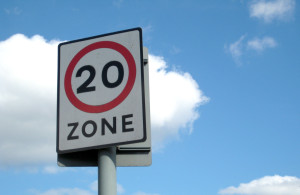
5 ideas to help Scotland leave the car behind
Our air pollution problem is mainly caused by traffic and our unhealthy relationship with the car, a relationship which the Scottish Government has fostered by spending millions every year on building new trunk roads and motorways, is creating a culture which is quite literally poisoning us.
With the election exclusion zone now in place around the Government, and Ministers not allowed to announce any new policies, we have decided to fill the void and put forward some policies of our own …
Here are just five politically possible transport suggestions to get Scots out of the car and on to their bikes, the bus or even on their feet walking!
- Twenty is plenty

The Government could make 20mph the default speed limit in all towns and cities. 20mph zones have been proven to work: a review of the first two hundred such zones across the UK saw average speed reductions of 9mph, and traffic flow within the zones falling by 27%. The annual number of accidents also fell by an incredible 60%.
By fostering a safer road culture, 20mph zones can lead to higher rates of walking and cycling. Edinburgh Council has already decided that twenty is plenty and with Glasgow and Dundee Councils exploring rolling out these zones, the Government should set a new standard for safer streets.
- Parking Levies
The Government should encourage Parking Levies for workplaces and other big destinations such as supermarkets. These levies should be negotiated with the involvement of recognised trade unions to ensure staff aren’t treated unfairly.
The UK’s first workplace parking levy in Nottingham has successfully cut the number of people driving to work and raised over £25m in its first three years. This money is benefiting the whole city as it is being ploughed back into upgrading the city’s train station and expanding their tram network.
- Congestion charging
This is another idea that has found success in several European cities. London’s congestion charge has seen traffic levels inside the charging zone drop by 75,000 vehicles per day, equivalent to a 20% decrease, with the level of congestion on roads surrounding the zone also down. Transport for London predicts that in the next few years the number cyclists entering the city at rush hour will actually surpass that of car drivers.
Local businesses within the zone continue to thrive, with central London’s retail sector now outperforming the rest of the UK and producing year-on-year growth. The £122m generated annually by the charge is spent on providing more bus services, improving road safety and implementing energy efficiency measures in transport.
- Get smarter on ticketing
The incoming Government should examine smart ticketing and ways to cut the costs of public transport to reverse the worrying trend whereby usage has fallen by 6% over the last decade.
Imagine if, rather than having to fumble in your bag for coins or nip to a shop to break a note into exact change for your bus fare, you could just pull out a smart card and enjoy the ride – wherever you are in Scotland. Smart ticketing systems like the Oyster card in London reduce queuing times, have been used as ways of reducing fares for card holders, and make public transport handier.
- Invest in cycling

Our rates of cycling in Scotland are growing but not rapidly enough. Many people have switched to the bike but some still feel that cycling is too risky. Edinburgh Council has set an exemplary standard in this regard: by increasing its spending on active travel year on year, it has seen levels of cycling soar, with almost 12% of trips to work now by bike.
If in the next Parliament, the Scottish Government were to increase its investment in walking and cycling from 1.9% to 10% of its total transport budget, this would go a long way to boosting cycling levels in Scotland.
Our dependency on the car causes air pollution, responsible for around 3,000 early deaths in Scotland each year. And the transport sector continues to belch out almost as much CO2 today as it did in 1990 and is the second largest single source of climate emissions in the country.
It doesn’t have to be this way. If we had fewer cars on the roads and a system where there was a suite of cheap, accessible and environmentally sustainable transport options, then we’d be healthier and closer to meeting our climate targets – and our journey times would be quicker. That’s what I would do if I was in charge!
Do you think that the next Scottish Government should implement any of these ideas or do you have any better ones yourself? Share your thoughts in the comments section below.
Emilia Hanna is Friends of the Earth Scotland’s air pollution campaigner. FoES are a part of the Stop Climate Chaos Scotland coalition.
